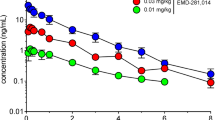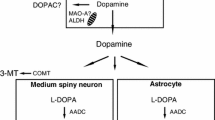Abstract
Rationale
Preclinical evidence indicates that D1 dopamine receptor full agonists have potential as therapeutic agents for a variety of neurological conditions. Dihydrexidine (DHX) was the first high potency selective D1 dopamine receptor full agonist and has been studied as a possible treatment for Parkinson's disease (PD). Recently, we discovered doxanthrine (DOX), an oxygen bioisostere of DHX that has even greater selectivity for the D1 dopamine receptor.
Objectives
Using the unilateral 6-hydroxydopamine-lesioned rat model of PD, DOX and DHX were compared at several doses (0.625, 1.25, 2.5, or 5.0 mg/kg) for their ability to elicit contralateral rotation by either intraperitoneal injection or oral gavage.
Results
After intraperitoneal administration, both DOX and DHX showed robust contralateral rotation at doses of 2.5 and 5.0 mg/kg compared to vehicle. In addition, after intraperitoneal administration at doses of 2.5 and 5.0 mg/kg, DHX had a significantly longer duration of action than DOX (p < 0.05). Areas under the curves (AUC) for DOX and DHX were not significantly different, however, indicating that DOX and DHX have similar potency after intraperitoneal administration. By contrast, after oral administration, 2.5 and 5.0 mg/kg of DOX produced significant contralateral rotations (p < 0.05), whereas DHX showed no significant activity after oral administration of any dose.
Conclusion
These results demonstrate that although DHX and DOX have similar activity after intraperitoneal administration, DOX demonstrated greater activity after oral administration compared to DHX. Despite its catechol functionality, DOX may possess sufficient oral availability for development as a human therapeutic agent.




Similar content being viewed by others
References
Asin KE, Wirtshafter D (1993) Effects of repeated dopamine D1 receptor stimulation on rotation and c-fos expression. Eur J Pharmacol 235:167–168
Bonuccelli U, Pavese N (2006) Dopamine agonists in the treatment of Parkinson's disease. Expert Rev Neurother 6:81–89
Braun A, Fabbrini G, Mouradian MM, Serrati C, Barone P, Chase TN (1987) Selective D-1 dopamine receptor agonist treatment of Parkinson's disease. J Neural Transm 68:41–50
Brewster WK, Nichols DE, Riggs RM, Mottola DM, Lovenberg TW, Lewis MH, Mailman RB (1990) Trans-10,11-dihydroxy-5,6,6a,7,8,12b-hexahydrobenzo[a]phenanthridine: a highly potent selective dopamine D1 full agonist. J Med Chem 33:1756–1764
Chopin P, Colpaert FC, Marien M (1999) Effects of alpha-2 adrenoceptor agonists and antagonists on circling behavior in rats with unilateral 6-hydroxydopamine lesions of the nigrostriatal pathway. J Pharmacol Exp Ther 288:798–804
Cueva JP, Giorgioni G, Grubbs RA, Chemel BR, Watts VJ, Nichols DE (2006) trans-2,3-dihydroxy-6a,7,8,12b-tetrahydro-6H-chromeno[3,4-c]isoquinoline: synthesis, resolution, and preliminary pharmacological characterization of a new dopamine D1 receptor full agonist. J Med Chem 49:6848–6857
Deumens R, Blokland A, Prickaerts J (2002) Modeling Parkinson's disease in rats: an evaluation of 6-OHDA lesions of the nigrostriatal pathway. Exp Neurol 175:303–317
Fahn S, Oakes D, Shoulson I, Kieburtz K, Rudolph A, Lang A, Olanow CW, Tanner C, Marek K (2004) Levodopa and the progression of Parkinson's disease. N Engl J Med 351:2498–2508
Foltynie T, Brayne C, Barker RA (2002) The heterogeneity of idiopathic Parkinson's disease. J Neurol 249:138–145
Gottwald MD, Aminoff MJ (2011) Therapies for dopaminergic-induced dyskinesias in Parkinson disease. Ann Neurol 69:919–927
Hickey P, Stacy M (2011) Available and emerging treatments for Parkinson's disease: a review. Drug Des Devel Ther 5:241–254
Jenner P (2008) Functional models of Parkinson's disease: a valuable tool in the development of novel therapies. Ann Neurol 64(Suppl 2):S16–S29
Johnson BJ, Peacock V, Schneider JS (1995) Dihydrexidine, a full D1 dopamine receptor agonist, induces rotational asymmetry in hemiparkinsonian monkeys. Pharmacol Biochem Behav 51:617–622
Kebabian JW, Britton DR, DeNinno MP, Perner R, Smith L, Jenner P, Schoenleber R, Williams M (1992) A-77636: a potent and selective dopamine D1 receptor agonist with antiparkinsonian activity in marmosets. Eur J Pharmacol 229:203–209
Lahti RA, Roberts RC, Tamminga CA (1995) D2-family receptor distribution in human postmortem tissue: an autoradiographic study. Neuroreport 6:2505–2512
Lewis SJ, Dove A, Robbins TW, Barker RA, Owen AM (2003) Cognitive impairments in early Parkinson's disease are accompanied by reductions in activity in frontostriatal neural circuitry. J Neurosci 23:6351–6356
Lin CW, Bianchi BR, Miller TR, Stashko MA, Wang SS, Curzon P, Bednarz L, Asin KE, Britton DR (1996) Persistent activation of the dopamine D1 receptor contributes to prolonged receptor desensitization: studies with A-77636. J Pharmacol Exp Ther 276:1022–1029
Meissner WG, Frasier M, Gasser T, Goetz CG, Lozano A, Piccini P, Obeso JA, Rascol O, Schapira A, Voon V, Weiner DM, Tison F, Bezard E (2011) Priorities in Parkinson's disease research. Nat Rev Drug Discov 10:377–393
Paxinos G, Watson C (1998) The rat brain in stereotaxic coordinates, 4th edn. Academic, San Diego
Perez-Lloret S, Rascol O (2010) Dopamine receptor agonists for the treatment of early or advanced Parkinson's disease. CNS Drugs 24:941–968
Przybyla JA, Cueva JP, Chemel BR, Hsu KJ, Riese DJ, McCorvy JD, Chester JA, Nichols DE, Watts VJ (2009) Comparison of the enantiomers of (+/−)-doxanthrine, a high efficacy full dopamine D(1) receptor agonist, and a reversal of enantioselectivity at D(1) versus alpha(2C) adrenergic receptors. Eur Neuropsychopharmacol 19:138–146
Riekkinen M, Jakala P, Kejonen K, Riekkinen P Jr (1999) The alpha2 agonist, clonidine, improves spatial working performance in Parkinson's disease. Neuroscience 92:983–989
Robin M, Forler C, Palfreyman MG (1985) Effect of chronic apomorphine on the development of denervation supersensitivity. Pharmacol Biochem Behav 22:547–551
Rodriguez-Oroz MC, Jahanshahi M, Krack P, Litvan I, Macias R, Bezard E, Obeso JA (2009) Initial clinical manifestations of Parkinson's disease: features and pathophysiological mechanisms. Lancet Neurol 8:1128–1139
Silver D (2006) Impact of functional age on the use of dopamine agonists in patients with Parkinson disease. Neurologist 12:214–223
Taylor JR, Lawrence MS, Redmond DE Jr, Elsworth JD, Roth RH, Nichols DE, Mailman RB (1991) Dihydrexidine, a full dopamine D1 agonist, reduces MPTP-induced parkinsonism in monkeys. Eur J Pharmacol 199:389–391
Tompson D, Oliver-Willwong R (2009) Pharmacokinetic and pharmacodynamic comparison of ropinirole 24-hour prolonged release and ropinirole immediate release in patients with Parkinson's disease. Clin Neuropharmacol 32:140–148
Ungerstedt U (1976) 6-Hydroxydopamine-induced degeneration of the nigrostriatal dopamine pathway: the turning syndrome. Pharmacol Ther B 2:37–40
Wooten GF (1997) Functional anatomical and behavioral consequences of dopamine receptor stimulation. Ann N Y Acad Sci 835:153–156
Yoshikawa T, Yoshida N, Hosoki K (1996) Involvement of dopamine D3 receptors in the area postrema in R(+)-7-OH-DPAT-induced emesis in the ferret. Eur J Pharmacol 301:143–149
Acknowledgments
This work was supported by a TRASK award from the Purdue Research Foundation and by the Robert C. and Charlotte P. Anderson endowment.
Author information
Authors and Affiliations
Corresponding author
Rights and permissions
About this article
Cite this article
McCorvy, J.D., Watts, V.J. & Nichols, D.E. Comparison of the D1 dopamine full agonists, dihydrexidine and doxanthrine, in the 6-OHDA rat model of Parkinson's disease. Psychopharmacology 222, 81–87 (2012). https://doi.org/10.1007/s00213-011-2625-5
Received:
Accepted:
Published:
Issue Date:
DOI: https://doi.org/10.1007/s00213-011-2625-5




